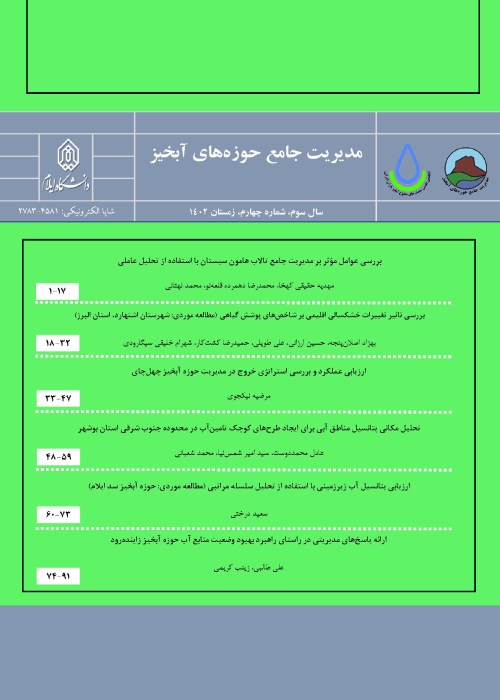Assessment of groundwater potential using hierarchical analysis (Case study: Ilam Dam watershed)
Drought and population increase are important factors that have caused more attention to ground water. Groundwater is one of the most valuable natural resources that affect human health, economic development and environmental diversity. Due to several inherent characteristics, these waters have become a very important and reliable source of water supply in developed and developing countries. Over the years, the importance of ground water due to the ever-increasing need for water has led to unscientific exploitation of ground water and the creation of water stress conditions. This alarming situation requires a cost-effective technique for proper assessment of groundwater resources and planning for the management of these resources. Geographic information system (GIS) and hierarchical analysis are samples of these tools. The purpose of this research is to prepare the ground water potential map using hierarchical analysis in the Ilam Dam watershed.
For this purpose, seven criteria of geology, slope, land use, soil, drainage density, lineament and precipitation were selected to identify the potential areas of ground water. The selection of these parameters is due to the effect that each of these factors has on the ground water. Geological features are important in controlling the infiltration of water into the ground due to the weathering, porosity and fracture that occur in them. On the other hand, increasing the slope of the land causes an increase in runoff. As drainage density increases, permeability decreases. Agricultural, forest and pasture land use can increase infiltration, but residential areas increase runoff due to impervious surfaces. Sandy and loamy soils have a high permeability coefficient, and finally, the higher the rainfall in the region, the higher the groundwater level. In order to prepare these layers, ArcGIS and remote sensing (RS) were used. First, by using the digital elevation model (DEM), the slope of the area, the drainage density in five classes were prepared. By using Landsat 8 satellite images of 2020 and in the environment of RS software, the land use of the region was created in five classes of agriculture, forest, pasture, bare soil and residential areas using a supervised classification method. Kappa coefficient confirmed 93% classification accuracy. The rainfall map of the watershed was also obtained from the synoptic and rain gauge station that existed in and around the basin. Finally, the geology map was prepared from the digital geological map in the GIS environment and the soil map from the Natural Resources Organization. After preparing these layers in the GIS, using the opinion of experts regarding the valuation of these criteria, each of these criteria was given grades from 1 to 9. Then, this valuation was transferred to Expert Choice software to determine the weight, and the weight of each criterion was obtained. Then, using these weights as well as raster layers created in the GIS environment and using the weighted overlay method, these layers were superimposed and the ground water potential map was obtained.
The results showed that geology criteria and land use have the most weight with 0.347 and 0.191, respectively, and soil and precipitation with 0.062 and 0.054 have the least importance for ground water potential. A big part of the watershed has medium to high potential for ground water. This part has a lot of forest and pasture cover, moderate slope (20-40 degrees) and high drainage density and high amount of precipitation, which is consistent with the results of Suri et al. (2016). A significant part of the basin has loam and sand soil, which have high permeability and can absorb water and increase the groundwater level. Kazhdomi formation has medium to high potential and Bangestan group formation has low potential.
In general, the final map has four potentials, including very low, low, medium to high, and very high, which respectively account for 0.98%, 41.8%, 55.9%, and 1.32% of the study area. Medium to high potential has the largest area. In general, the north of the watershed has medium to high potential, the south of the watershed has low potential, and a small part of the east of the study area has high potential of ground water. Preparing a map of ground water potential in watersheds can be a suitable strategy for exploiting these resources.
- حق عضویت دریافتی صرف حمایت از نشریات عضو و نگهداری، تکمیل و توسعه مگیران میشود.
- پرداخت حق اشتراک و دانلود مقالات اجازه بازنشر آن در سایر رسانههای چاپی و دیجیتال را به کاربر نمیدهد.



